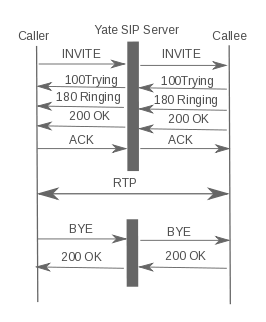SIP in Yate
Contents |
Yate Server as a SIP - B2BUA
Yate is a back-to-back user agent (B2BUA) that is a logical entity that receives a request and processes it as a user agent server (UAS). In order to determine how the request should be answered, it acts as a user agent client (UAC) and generates requests to destination end, handling the signalling between end points back-to-back. Yate is not a Proxy Server, he does much more than that:
- maintains a complete state for the calls
- handles automatic call disconnection or call transfer
- conceals the caller identity
- generate requests of their own and also final responses
- can provide NAT traversal solution
- can interwork with different networks
- can overwrite and modify the SIP headers like Contact, Via, Route.
Yate implements SIP protocol that runs on User Datagram Protocol (UDP) and Transmission Control Protocol (TCP), but not on Stream Control Transmission Protocol (SCTP).
Yate can act as a SIP Server as you can see in the image below and also you can configure Yate to be a SIP Client.
The flow for this messages is similar to the HTTP request/response transaction model.
A transaction occurs between a user agent client (UAC) and a user agent server(UAS), and comprises all messages from the initial request to the final response.
The first line tells us that this is INVITE message which is used to establish a session.
The responses can be provisional, starting with 1 followed by two digits (for example, "180 Ringing") or final starting with 2 followed by two digits (for example, "200 Ok").
The scope of a transaction is defined by the stack of the Via headers of the SIP messages.
After 100 Trying message is sent if no message arrives to Caller then Yate will send a copy of the first INVITE, this is called retransmission and the flow of the messages will continue. A dialog is established, such as INVITE to an request a 2xx response - the action was successfully received, understood, and accepted.
As you can see in the image, the RTP can pass directly from caller to the callee once the transaction is established, or the RTP can go through Yate and Yate will send the SDP to callee.
How to configure SIP in Yate
Using the default configuration from ysipchan.conf file, Yate will behave as a SIP server, that will listen on all interface or you can configure your own listeners. In Yate you can build UDP, TCP, TLS listeners.
More about routing you can find here.
SIP with NAT in Yate
IN [general] section from file ysipchan.conf the nat setting will try to replace nonroutable IP addresses of the RTP media stream with the address the SIP signalling was received from. This significantly improves chances that clients behind a dumb NAT get normal voice. This option is enabled by default, you just have to remove ';' that makes the line a comment in the file.
ISUP signalling
In Yate, ISUP signalling is encapsulated in SIP and it is done using protocol: SIP-T. The other way is SIP-I but is not supported by Yate.
In section [sip-t] enable parameter isup that will build outgoing or decode incoming application/isup bodies.
If enabled an incoming application/isup body will be decoded and added to the engine message issued by the receiving channel.
If the channel needs to add more then one body to an outgoing message, a multipart/mixed body will be attached to the message.
DTMF methods
In section [general] parameter dtmfmethods configures the allowed methods and the order they are tried:
- rfc2833 Send DTMFs as RFC2833 RTP signals. This method will be used if media is started and remote party advertised telephone event support in SDP.
- info Send DTMFs using SIP INFO method.
- inband Send DTMFs in audio stream. This method will succeed if media is started, the tone generator module is loaded and there is a translator from PCM (yate 'slin' format) to current rtp format
More information about how to send DTMFs you can find here.
Codecs supported in Yate
The [codecs] section allows to individually enable or disable the codecs. This is a list of supported codecs:
- default - Enable all unlisted codecs by default if a transcoder exists
- mulaw - Companded-only G711 mu-law (PCMU/8000)
- alaw - Companded-only G711 a-law (PCMU/8000)
- gsm: - European GSM 06.10 (GSM/8000)
- lpc10 - Linear Prediction Codec (LPC/8000)
- ilbc - Internet Low Bandwidth Codec (iLBC/8000)
- amr - Adaptive Multi-Rate 3GPP (AMR/8000)
- slin - Signed Linear 16-bit uncompressed (L16/8000)
- g723 - ITU G.723 all variations (G723/8000)
- g726 - ITU G.726 32-bit (G726-32/8000)
- g728 - ITU G.728 all variations (G728/8000)
- g729 - ITU G.729 all variations (G729/8000)
- g729_annexb - G.729 Annex B (VAD) support default (if not in SDP)
- amr_octet - Octet aligned AMR RTP payload default (if not in SDP)
Listeners set in Yate
Listeners in Yate can be set in section called [listener name] and this will tell Yate on which interface to listen. More information about listeners you can find here.
More information about SIP Protocol.

